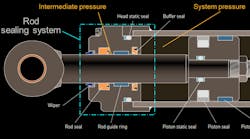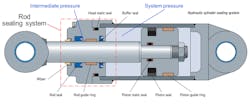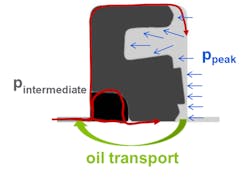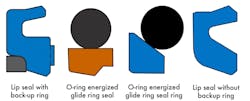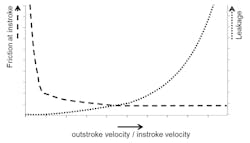How Buffer Rod Seals Influence Rod Seal Performance
Click here for Part 2 of this series.
At a Glance:
- Buffer seals protect equipment against pressure spikes.
- The key factor with buffer seals is the thin film of oil it lets past.
- The main types of buffer seals are lip seals with back-up rings, lip seals without back-up rings and O-ring energized glide ring seals, each with their own performance characteristics.
Designers often specify buffer seals be placed in front of primary rod seals in heavy-duty hydraulic applications to extend the life of the seals. As the name indicates, buffer seals “absorb” pressure spikes typical on heavy-duty cylinders to protect the primary rod seals.
But how do these two types of seals interactions interact, which parameters affect those interactions, and how can they be used to extend the life of cylinder rod-sealing systems?
What was learned during these investigations will give engineers insights into seal types and interactions between seals so they can specify the most appropriate seals for their applications.
Buffer Seal Basics
A buffer seal must:
- Absorb system pressure spikes that could damage the primary rod seal.
- Let oil move past the seal lip to lubricate the primary rod seal and wiper.
- Vent intermediate pressure (see below) between the buffer and primary rod seal when system pressure is below the intermediate pressure, thereby preventing a pressure trap.
The primary rod and buffer seals must:
- Prevent leaks by reducing lubrication film thickness and allow back-pumping into the system.
- Adjust lubrication film thickness so there are the fewest and smallest possible leaks and low friction.
- Absorb intermediate pressure.
And the wiper must:
- Keep out all kinds of environmental contamination.
- Prevent leaks by pumping lubricant back into the system.
- Vent intermediate pressure between rod seals and wipers.
(This article focuses on the buffer and rod seals; wipers are not included.)
The key element of the buffer seal is the lubrication film thickness which passes the sealing edge. It is responsible for the performance of the entire rod sealing system. Different pressure and speed conditions during the in- and outstroke of the piston rod are typical for heavy-duty hydraulic cylinders and result in different oil film thickness. Therefore, the buffer seal needs to be designed to ensure a lubricated rod seal and absorb pressure peaks during operation.
Generally, buffer seals use one of two basic design principles:
High sealability buffer seals have good sealing abilities and can handle all of the system pressure and possible pressure peaks. Therefore, the primary rod seal will not be pressurized and can’t be damaged by pressurization. The seal’s high sealability means only a thin film of lubrication film can pass it, which could cause starve the primary rod seal of lubrication. This can lead to stick-slip, higher friction and sealing-edge temperatures, and possibly damage to the sealing material, all of which shorten the rod seal’s life.
Friction optimized buffer seals let thicker oil film pass the sealing edge to properly lubricate the primary rod seal. Depending on operating conditions, they can also let pressure build-up between the primary rod and buffer seals (intermediate pressure).
These buffer seals should keep out system pressure, because if the intermediate pressure is equal to system pressure, it cannot buffer. It is also important to use a primary rod seal and a wiper for good sealing and back-pumping ability to guarantee a leak-tight system.
An additional advantage of this type of seal is that the primary rod seal gets better lubrication, leading to smooth running equipment. If the buffer and primary rod seal work together correctly (as described above), friction in the entire rod sealing system can be similar to that of a single rod seal component. Reducing friction extends the life of the rod seal and the entire hydraulic cylinder.
Both working concepts have their place. Friction optimized buffer seals might be best in OEM components to extend a hydraulic cylinder’s service life. But high-sealability buffer seals might be more suitable in the aftermarket, where repair work and maintenance on hydraulic cylinders is more common and a leak-tight rod seal is more important.
Buffer Seal Designs
There are many different buffer seal designs and various material combinations available on the market. Here are the three most common designs.
Lip seals with back-up rings. These seals are good in heavy duty applications, where pressure spikes climb past 600 bar. The best lip seals are made of polyurethane with a thermoplastic back-up ring. This design enjoys a longer service life because the back-up ring resists extrusion. On the other hand, the back-up ring can influence the motion of the film of fluid on the piston rod, and seal installation requires more attention.
O-ring energized glide ring seals. These seals are widely used in light- to medium-duty application. Generally, the O-ring acts as an energizer to push the glide ring towards the piston rod. A big advantage of this is that various materials can be used. For example, a low temperature rubber grade can be used for cold climate conditions. The various material combinations give designers a wide choice. These seals have less resistance to extrusion compared to those with back-up rings.
Lip seals without back-up ring. These are popular in Asia. This type of buffer seal has a radius on the seal lip to let oil past it. They are cost-competitive but are also as limited in pressure and extrusion resistance, and don’t perform as well at absorbing pressure spikes.
The buffer seal’s main task is keeping the lubrication film thickness that passes through the seal’s edge at the right thickness. According to the Reynolds equation, the flow of a thin film oil/lubricant between two surfaces is influenced by its velocity, the gradient of the contact pressure distribution and the oil’s viscosity.
An important aspect of the investigations was to understand lubrication behavior under different test parameters. The lubrication level of lubrication determines friction and is essential for seal life. On the other hand, the lubrication level also determines the number and size of leaks, which should be minimized for the sake of performance and environmental concerns.
The lubrication level is influenced by instroke and outstroke piston-rod velocity, seal design and the type of hydraulic oil used.
The influence of different in- and outstroke velocities has already been analyzed for a common U-Cup rod seal (see above graph). The results show that if outstroke velocity is much higher than instroke velocity, the likelihood of leaks increases. On the other hand, if instroke velocity is much higher than outstroke velocity, it is more likely the low-level of lubrication will increase friction on the instroke.
The second driver for the lubrication film thickness is contact pressure between the seal and piston rod. The higher the pressure gradient, the thinner the film. The gradient is influenced by seal design, the pressurization level, and the resulting deformation and dynamics between piston rod and seal.
The third driver for the lubrication film thickness is the lubricant’s viscosity. The lower the viscosity, the thinner the lubrication film.
In the second installment of this series, tests will be set up and run and the results analyzed, revealing what factors of buffer seals matter most to rod seal performance and longevity.
Thomas Schwarz is manager of testing, materials technologies & research; Wolfgang Swete is manager of product technology and development; Silvio Schreymayer is manager of testing; Martin Wallner is the manager of product development; Emmanuel Pichlmaier is a product development engineer; and Michael Liebminger is a testing engineer for SKF Seals.
